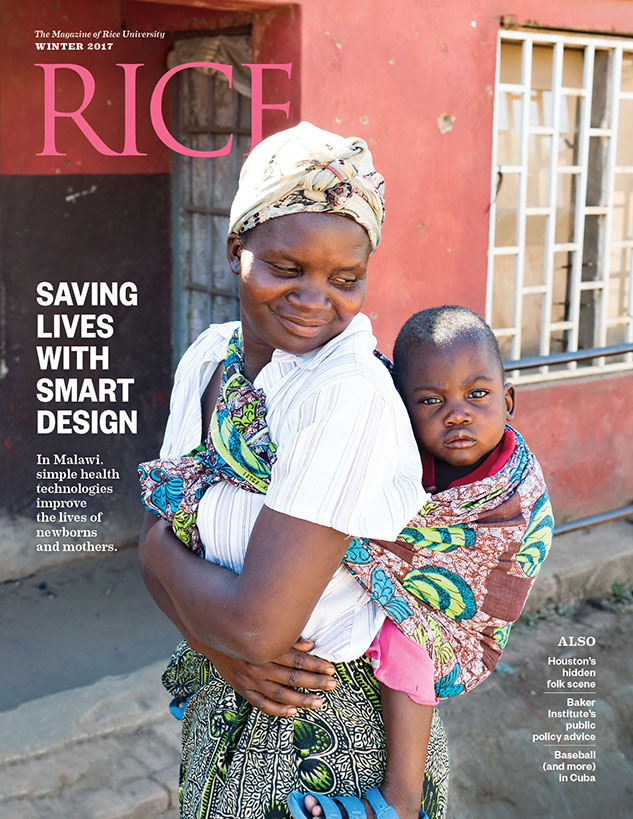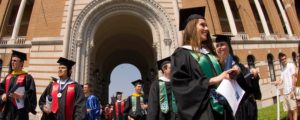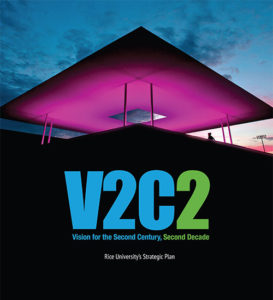Findings, research, publications and more
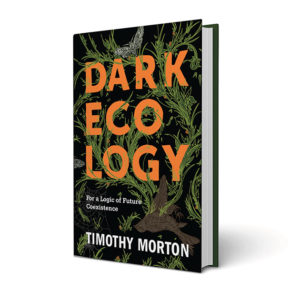 Dark Ecology: For a Logic of Future Coexistence
Dark Ecology: For a Logic of Future Coexistence
by Timothy Morton (Columbia University Press, 2016)
Part philosophical treatise, part historical account and part lyric essay, “Dark Ecology” offers a playful, poetic parsing of our era’s environmental crisis, focused less on the ecological challenges we face than on the ways we’re facing them. Morton, the Rita Shea Guffey Chair in English at Rice, is interested in how humans make meaning of an increasingly fragile world, offering a theory-driven analysis that draws more heavily from Jacques Derrida and Martin Heidegger than from Rachel Carson and John Muir. “What is dark ecology?” he asks rhetorically. “It is ecological awareness, dark-depressing. Yet ecological awareness is also dark-uncanny. And strangely it is dark-sweet.”
Morton is the author of numerous other books, including “Hyperobjects: Philosophy and Ecology After the End of the World” and “Ecology Without Nature.” He blogs at ecologywithoutnature.blogspot.com.
— J.L.
[tw-divider][/tw-divider]
 Border Lives: Fronterizos, Transnational Migrants and Commuters in Tijuana
Border Lives: Fronterizos, Transnational Migrants and Commuters in Tijuana
by Sergio Chávez(Oxford University Press, 2016)
Chávez, an assistant professor of sociology at Rice, spent the better part of a decade studying “livelihood strategies” in Tijuana. “Border Lives,” the culmination of his years of research — and 158 interviews with border residents — explores the resourcefulness and adaptability those residents demonstrate in negotiating rapidly shifting immigration and border enforcement policies in the face of economic instability and social inequalities. The very geography of Tijuana, known by locals as la ciudad del brinco (jumping-point city), both constrains and enables mobility, as Chávez illustrates.
“By examining the strategies that people … employ to cross the border, find work, and settle into the borderlands across time and space, this book provides a nuanced picture of how people reproduce social structure and challenge —successfully and unsuccessfully — the very system which restricts their mobility and livelihood options,” Chávez writes. — J.L.
[tw-divider][/tw-divider]
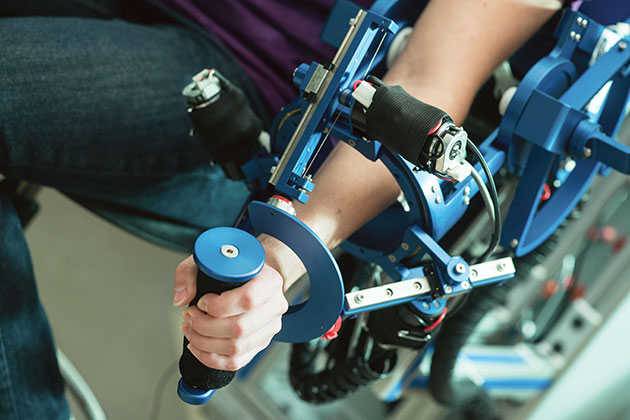
Photo by Jeff FItlow
ROBOTICS RESEARCH HOLDS PROMISE FOR STROKE SURVIVORS
- Stroke survivors often lose the use of limbs and struggle to regain control
- A robotic exoskeleton,coupled with the power of survivors’ own thoughts, may help patients relearn how to use their arms and legs
Can stroke survivors “think” their disabled limbs into motion? The research of Marcia O’Malley, associate professor of mechanical engineering and computer science at Rice, is heading in that direction.
O’Malley and her collaborators have developed a robotic orthotic device that revolutionizes upper-limb rehabilitation. The neurotechnology interprets brain waves and makes it possible for stroke patients to operate an exoskeleton surrounding the arm from fingertips to elbow. O’Malley’s lab is developing the exoskeleton, while researchers at the University of Houston work on the electroencephalograph (EEG)-based neural interface. The device has been tested by UT Health physicians on volunteer patients.
“Our results are promising,” O’Malley said. “We know we can help people who have suffered a stroke.”
EEG devices translate brain waves from healthy subjects into control outputs to operate the robot, and then from stroke survivors who have some ability to initiate movements, to prompt the robot into action. This permits the team to refine the EEG-robot interface before moving to stroke patients without residual upper-limb function. Repetitive motion has proven effective at retraining motor nerve pathways damaged by a stroke, but patients must be motivated to do the work.
O’Malley and research assistant Jennifer Sullivan ’11 traveled to Capitol Hill in June to share their work with lawmakers. The research is funded by a $1.7 million grant from the National Institutes of Health and Neurological Research Institute. — PATRICK KURP
[tw-divider][/tw-divider]
 FROM ISLAMIC HISTORY, LESSONS ON RELIGIOUS FREEDOM
FROM ISLAMIC HISTORY, LESSONS ON RELIGIOUS FREEDOM
- Prophet Muhammad authored covenants, or agreements, with Christian communities
- Rice sociologist’s analysis shows how Muhammad valued freedom of religion and civil rights
Prophet Muhammad believed that freedom of religion and civic rights were important components of a “Muslim nation,” according to a new analysis of the prophet’s covenants with Christians. Research by Rice sociology lecturer Craig Considine — published recently in the journal Religions — shows how the agreements emphasized tolerance. “These covenants were designed to protect and even defend peaceful Christian communities, not attack them,” Considine said.
Considine studied covenants written between 622 and 632 A.D. Scholars have found the documents in obscure monasteries around the world and in books that have been out of print for centuries. All four covenants examined in the paper include an emphatic paragraph on the issue of religious freedom.
“And even as they honor and respect me, so shall Muslims care for that people as being under our protection and whensoever any distress or discomfort shall overtake (Christians), Muslims shall hold themselves in duty bound to aid and care for them, for they are a people subject to my Nation, obedient to their word, whose helpers also they are,” Muhammad wrote.
Considine said that as violence against Christians continues in countries such as Iraq and Syria, scholars and believers can point to the covenants as evidence that Islamic teaching cannot justify violence. “Prophet Muhammad’s covenants with Christians can be viewed as a kind of medicine to cure the diseases of Islamic extremism and Islamophobia,” he said. “His message radiates compassion and peace.” — AMY MCCAIG
[tw-divider][/tw-divider]
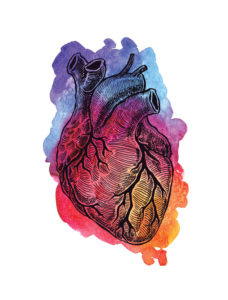 BUILDING A BETTER SYNTHETIC HEART VALVE
BUILDING A BETTER SYNTHETIC HEART VALVE
- Few options exist for replacing natural heart valves
- The polymer hyaluronan can serve as a versatile template for growing tissue
- Gel-based scaffolds degrade as the cells grow into natural tissue
Heart valves typically work for decades without pause. They’re among the strongest and most durable tissues in nature, and unfortunately for sufferers of heart-valve disease, the options to repair or replace them are still limited.
Jane Grande-Allen, professor of bioengineering, and her colleagues have found that a natural polymer called hyaluronan, one of the chief components of skin and connective tissue, can serve as a versatile template for growing spongiosa, the middle tissue layer in the valve’s leaflets. The team, whose research recently appeared in the journal Biomacromolecules, is working toward the construction of replacement heart valves from materials that match those produced by nature as precisely as possible.
“It’s worth pursuing more gel-based scaffolds in tissue engineering,” Grande-Allen said, “because these can be easily tuned to match the stiffness of natural tissue, and researchers can encapsulate cells during cross-linking to study them in a 3-D environment.”
The study determined that naturally produced hyaluronan performed as well as a synthetic hydrogel, polyethylene glycol diacrylate, as a template for growing new spongiosa tissue. They reported that the stiffness of either hydrogel and the presence of a peptide known as RGDS could be even more influential in controlling a cell culture’s behavior. — MIKE WILLIAMS
[tw-divider][/tw-divider]
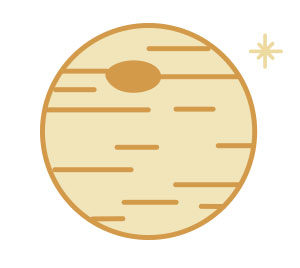 A GIANT PLANET WITH A YOUNG STAR
A GIANT PLANET WITH A YOUNG STAR
- A mammothplanet orbits a2 million-year-oldstar in theTaurus constellation
- The finding calls into question ideas about how planets form
- It’s at least eight times the sizeof Jupiter
- The recent discovery of a giant planet called CI Tau b contradicts the long-standing idea that larger planets take longer to form.
Christopher Johns-Krull, professor of physics and astronomy, and a dozen co-authors worked on the study, which will be published in The Astrophysical Journal.
Earth and the sun are more than 4 billion years old, and while the 3,300-plus catalog of exoplanets includes some older and some younger than Earth, the obstacles to finding planets around newly formed stars are varied and daunting, Johns-Krull said.
There are relatively few stars that are young enough, give off enough light to see clearly with telescopes and still retain circumstellar disks of gas and dust from which planets form. Stars so young also are often active, with visual outbursts and dimmings, strong magnetic fields and enormous starspots that can make it appear that planets exist where they do not.
CI Tau b orbits the star CI Tau every nine days. It was found with a planet-hunting technique that relies upon slight variations in the velocity of a star to determine the gravitational pull exerted by faint nearby planets. Johns-Krull said the team has examined about half of the young stars in the survey sample, and the data from several of these suggest that more planets may be found. — JADE BOYD
[tw-divider][/tw-divider]
 THE COST OF ‘RIGHT TO TRY’ LAWS
THE COST OF ‘RIGHT TO TRY’ LAWS
- The “right to try” movement has pushed for giving terminally ill patients faster access to early-stage therapies
- Science policy experts worry that these laws compromise safety and efficacy
Since 2014, a major movement of patient advocates has worked to hasten access to experimental medical treatments. As a result, a number of state legislatures, including in Texas, have passed “right to try” laws designed to give terminally ill patients access to early investigational drugs before full Food and Drug Administration (FDA) approval.
But these laws may make safety and efficacy secondary to speedy access, according to a new report by Kirstin Matthews, senior fellow at Rice’s Baker Institute for Public Policy, and Michelle Rubin, from Baylor College of Medicine.
“The goal of the laws is to remove the FDA and ethical oversight required in the expanded access application process,” the authors wrote. “However, these are important oversight mechanisms that can prevent harm and promote informed decision-making.”
The chance to access investigational drugs can naturally raise the hopes of patients and families, the authors said. “However, many policy scholars, physicians and scientists believe this can be a false hope and criticize the laws for, at times, causing more stress in a terminally ill patient’s life. ‘Right to try’ laws can perpetuate the idea that an experimental drug is worth the risk and potential danger, despite the fact that 85 percent of experimental drugs fail during clinical trials.”
Instead of focusing on removing regulation, the authors recommended that patients and advocates work with the FDA to improve access issues, perhaps through subsidies or tax breaks that would incentivize companies to provide the drug at little or no cost. The FDA has already started the process of revising its application process to make it less cumbersome. — JEFF FALK
[tw-divider][/tw-divider]NEW ANSWERS TO WHY EARTH’S ATMOSHPHERE HAS OXYGEN

- New modelsuggests that the rise of oxygen on Earth was a result of plate tectonics and continents formedin the presence of life
- Oxygen levels spiked 2.5 billion years ago and600 million years ago
Today, some 20 percent of Earth’s atmosphere is free molecular oxygen, or O2. But for much of Earth’s 4.5 billion-year history, free oxygen was all but nonexistent in the atmosphere. Understanding how this change happened is key to our knowledge of the planet’s early history. Now new research suggests that the rise of oxygen was an inevitable consequence of continent formation, life and plate tectonics.
The research team, led by Rice Earth Science Professor Cin-Ty Lee, published its findings in Nature Geoscience. Lee co-authored the study with Laurence Yeung, assistant professor of earth science, and Adrian Lenardic, professor of earth science, and with Yale’s Ryan McKenzie and the University of Tokyo’s Yusuke Yokoyama.
Lee and colleagues showed that around 2.5 billion years ago, the composition of Earth’s continental crust fundamentally changed.
“We believe the first rise in oxygen may have been due to a substantial reduction in the efficiency of the oxygen sink,” Lee said. He invoked the leaky bathtub analogy, in which the sources and sinks of oxygen and carbon dioxide are imagined as water flowing in and out of a tub. “This is equivalent to partially plugging the drain.”
The study also suggests that the second rise in atmospheric oxygen, 600 million years ago, was related to a change in production — analogous to turning up the flow from the faucet.
Lee and his team’s work predicts that production of carbon dioxide must increase with time, a finding that goes against the conventional wisdom that carbon fluxes and atmospheric carbon dioxide levels have steadily decreased over the last 4 billion years.
“The change in flux described by our model happens over extremely long time periods, and it would be a mistake to think that these processes that are bringing about any of the atmospheric changes are occurring due to anthropomorphic climate change,” he said. “However, our work does suggest that earth scientists and astrobiologists may need to revisit what we think we know about Earth’s early history.” — JADE BOYD
[tw-divider][/tw-divider]
BAD COUPLE: STRESS AND DIABETES
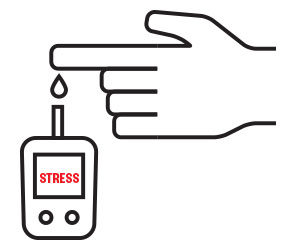
- Researchers have suspected a biological pathway between anxietyand poor health,including diabetes
- Interventions may include anti-inflammatory medications, cognitive behavioral therapy and mindfulnesstherapy
A Rice study has found a link between emotional stress and diabetes, with roots in the brain’s ability to control anxiety.
The research establishes a metabolic chain reaction that starts with low inhibition, or attention control, which leaves a person vulnerable to tempting or distracting information, objects, thoughts or activities. Previous studies have shown that such vulnerability can lead to more frequent anxiety, and anxiety is known to activate a metabolic pathway responsible for the production of pro-inflammatory cytokines, signaling proteins that include interleukin-6 (IL-6).
Along with cognitive tests that measured attention control, the Rice study measured levels of both blood glucose and IL-6 in more than 800 adults. IL-6 is a biomarker of acute and chronic stress that also has been associated with a greater likelihood of diabetes and high blood glucose. The research showed individuals with low inhibition were more likely to have diabetes than those with high inhibition due to the pathway from high anxiety to IL-6.
“The literature shows individuals with poor inhibition are more likely to experience stressful thoughts and have a harder time breaking their attention away from them,” said Kyle Murdock, lead author of the study. “That made me wonder if there’s a stress-induced pathway that could link inhibition with inflammation and the diseases we’re interested in, such as diabetes.” Murdock is a postdoctoral research fellow in the Rice lab of Christopher Fagundes, assistant professor of psychology.
“Individuals who are anxious are more likely to avoid treatment and use maladaptive strategies (like smoking or unhealthy diets) that enhance their blood glucose, which is problematic. It’s a snowball effect: The further they go, the worse it gets,” Murdock said. The National Institute on Aging and the National Heart, Lung and Blood Institute supported the research. — MIKE WILLIAMS
[tw-divider][/tw-divider]
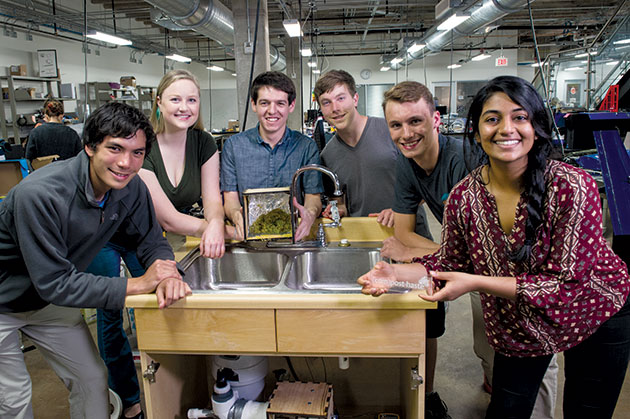
Photo by Jeff FItlow
A BETTER WAY TO COMPOST
- A studentengineering design team prototyped The BioBlend, a device that turns food waste into a highly compostable form
- Chalmers University of Technology in Sweden is testingthe device
- BioBlend produces finely chopped waste that turns into compost faster than regular garbage
A student engineering design team invented a device that sits under a sink and takes macerated food waste produced by a standard garbage disposal and sends it in one direction while liquid waste (including water) goes in another. It simplifies the process of recycling garbage into a useful product, while helping to protect water supplies.
The members of the design team, (com)-post-haste, included Kavana Gowda, Christina Petlowany, Andrew Miller, Edgar Silva, Mitch Torczon and Ryan Yeh, all members of the Class of 2016. They spent much of last year working in the basement of Rice’s Oshman Engineering Design Kitchen, where they installed an actual research kitchen — or at least the sink part.
The project is a partnership with NASA, which has an interest in such devices for outposts on the moon, Mars and beyond, and with Chalmers University of Technology in Sweden, which pitched Rice on the project and intends to install The BioBlend at its Living Lab, where it will be tested alongside other emerging household technologies.
“One of the things our sponsors want to see is if they can make the device large enough to put in the basement of an apartment complex or a grocery store or restaurant — places with a ton of food waste,” Torczon said. “They could create a lot of biogas they could then turn around and sell or, if they’re in a restaurant, use themselves.”
Whether it’s used for compost or biogas production, the key to the invention’s success will be its ability to keep garbage out of wastewater treatment plants, where it’s not only useless but also costly and complicated to remove.
The teammates had no problem finding a way to feed their creation. “One of the cool things about the project was digging once a week through the trash in the Rice serveries,” Yeh said. Matthew Elliott, lecturer in mechanical engineering, was the team’s faculty adviser. — MIKE WILLIAMS
A studentengineering design team prototyped The BioBlend, a device that turns food waste into a highly compostable form
Chalmers University of Technology in Sweden is testingthe device
BioBlend produces finely chopped waste that turns into compost faster than regular garbage
[tw-divider][/tw-divider]
HEY HOUSTON … WHAT’S YOUR BIG PROBLEM?
Houston area residents are remarkably optimistic about jobs and the future, according to Rice University’s 35th annual Kinder Houston Area Survey, conducted by Rice sociologist and Kinder Institute Founding Director Stephen Klineberg. Residents also rate Houston more favorably than ever, while continuing a long-term trend toward becoming more secular and more aligned with the Democratic Party.
Here is a sampling from this year’s findings:




